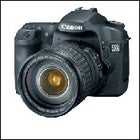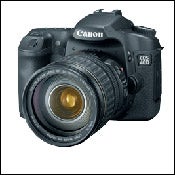Oh, Paul. I do not have a good answer. But I so love the question that I have to bring it up in the hope that someone can chime in and help. I actually know a little bit about this. Last year I wrote a piece for Smithsonian Air & Space Magazine about commercial uses of UAVs. For instance, a UAV called a a $7,000 UAV used by farmers to evaluate field conditionsuses a simple Optio A40 ($300), a point-and-shoot with 12-megapixel resolution. And it can resolve things down to six inches from 2,000 feet up. Thirty times as high, that means even a humble Optio can come close to your six-feet-by-six-feet target=.
 The EOS D40
The EOS D40Get a digital SLR with a good lens, and you could see if that quarter on the ground is heads or tails. With a EOS D40 ($1,200 for body) you get a pro-grade camera thats designed for harsh conditions, such as the freezing encountered at 60,000 feet. Id add a short zoom, such as s 24-60mm f/2.8 EX DG IF Aspherical Wide Angle Zoom Lens ($560). Very sharp, good versatility. And the combination shouldn’t tax a smallish UAV, weight-wise. Mainly, youd want a good pilot so you dont smash the thing up and lose the expensive camera.
In short, any good-quality digital camera should give you the resolution you need. I have some concerns around whether it will be so cold (-70 degrees) that high up that any camera will just freeze up, or the battery will cease to function. Perhaps adding some sort of heater to the camera may be a necessary step.
Good luck! And if any readers have any ideas, please let me know!


